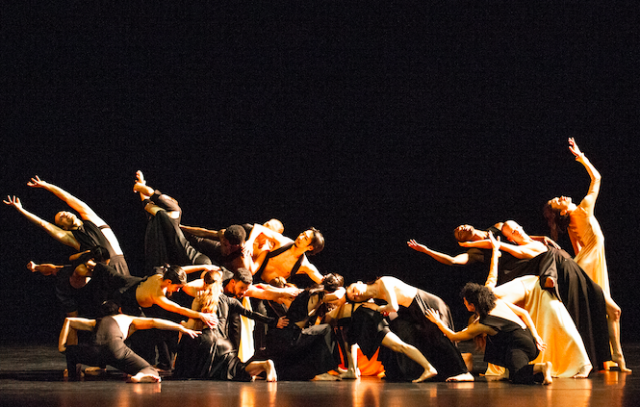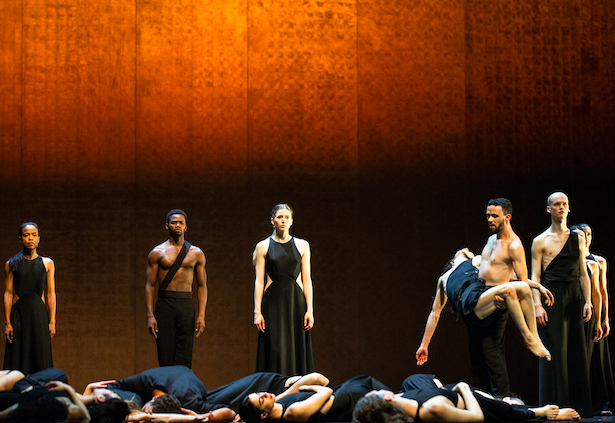
For the English version, please, scroll down.
BERLINO – Dopo due anni dalla data originariamente prevista per il suo debutto, questa settimana è finalmente andato in scena Sym-phonie MMXX di Sasha Waltz.
Quando era stata nominata co-direttrice artistica dello Staatsballett Berlin (2019/2020), la famosa coreografa tedesca aveva chiesto a Georg Friedrich Haas di comporre le musiche per il pezzo che avrebbe creato per la più grande compagnia di danza in Germania. Il compositore austriaco, allontanandosi dallo stile brillante a cui ci ha abituati, scrisse una musica struggente che ha influenzato e determinato la drammaturgia del pezzo. Il risultato è un’opera drammatica nell’estetica e nei contenuti.
Il lancio di sassi in scena ci riporta all’orrore della guerra
L’inizio dello spettacolo è caratterizzato dalle pose statuarie e liriche che assumono i danzatori della Sasha Waltz & Guests a cui seguono scene corali di ‘rappresaglia’. Originariamente questa parte probabilmente rappresentava la sfida personale che stava per affrontare la Waltz nell’introdurre elementi nuovi e di rottura nell’ambito dello Staatsballett, e, più in generale, la lotta degli individui nei confronti del sistema con le sue istituzioni. Oggi, le scene in cui i danzatori lanciano sassi contro qualcosa o qualcuno, inevitabilmente portano alla mente l’orrore della guerra in Ucraina. Le lunghissime pause musicali, oltretutto, amplificano il pathos della scena in cui due danzatori sollevano e spostano in proscenio i corpi dei loro compagni, che appaiono esanimi e in fin di vita.
Il finale con il soffitto che si abbassa lascia poche speranze sul futuro
Nella seconda parte dello spettacolo, finora un po’ lento e forse ancora non completamente univoco nelle intenzioni dei singoli danzatori, si cambia registro. Invece che parti corali, prevalgono scene in cui vi è un protagonista con le sue emozioni. Dal gruppo, quindi, si passa all’individuo, per arrivare a un finale in cui il soffitto si abbassa lasciando poche speranze per il futuro. L’ombra che scende sembra opprimere i sogni e segnare il destino dell’uomo, fino a schiacciarlo.
Bellissimi i costumi, magistrale l’uso dello spazio e sapiente l’uso delle luci.
Sym-phonie MMXX, pur non essendo un pezzo sperimentale o innovativo, è un’opera che ha il merito di andare oltre il tempo, di provocare emozioni e consegnare messaggi che, a prescindere dal momento in cui si vive, troveranno sempre una corrispondenza nelle coscienze del pubblico di oggi e anche di domani.

Two years after the originally planed debut, this week Sym-phonie MMXXX by Sasha Waltz was finally on.
When Sasha Waltz was nominated artistic co-director of the Staatsballett Berlin (2019/2020), she asked Georg Friedrich Haas to compose the music for the pièce she would create for the biggest dance company in Germany. The Austrian composer, moving away from the brilliant style to which he accustomed us, wrote a poignant music that influenced and determined the dramaturgy of the performance. The result is a dramatic pièce in terms of aesthetics and content.
The beginning of the show is characterized by the statuesque and lyrical poses assumed by the dancers of Sasha Waltz & Guests followed by choral scenes of ‘retaliation’. Originally this part probably represented the personal challenge that Waltz was about to face in introducing new and breaking elements within the Staatsballett, and, more generally, the struggle of individuals against the system and its institutions. Although nowadays the scenes in which dancers throw stones at something or someone inevitably suggest the horror of the war in Ukraine. The very long musical pause amplify the pathos of the scene in which two dancers lift and carry their companions’ bodies, which appear lifeless or dying.
Though in the first half of the performance that was flowing quite slowly and in which each dancer seemed to struggle delivering a common interpretation, the second part welcomes a change of register. Here the scenes revealing the protagonist’s emotions prevale over the choral ones. The scene in fact switches from the group to the individual and comes to an ending in which the ceiling comes down leaving little hope in the future. The shadow that descends seems to oppress the man’s dreams and mark his destiny until he crushes under it.
The costumes are beautiful, the use of space is masterful and the use of lights is skilful.
Sym-phonie MMXX might not be an experimental or innovative pièce but it surely is a work that goes beyond time provoking emotions and delivering messages that will always find a correspondence in the consciences of today’s and tomorrow’s audiences, regardless of the time one lives in.
Concept and choreography: Sasha Waltz. Music: Georg Friedrich Haas. Stage design: Pia Maier Schriever. Costume design: Bernd Skodzig. Lighting design: David Finn. Musical direction: Ilan Volkov. Staatskapelle Berlin. With dancers of Sasha Waltz & Guests.














































